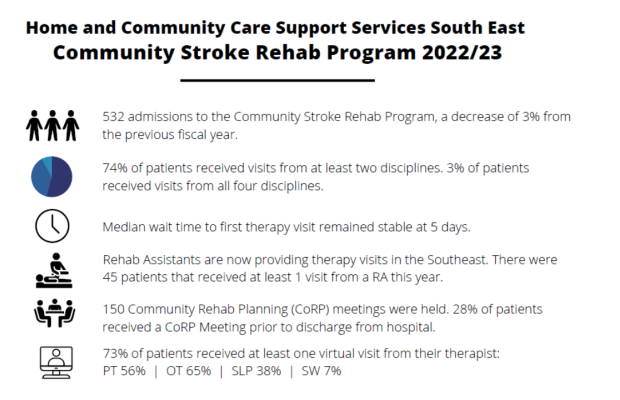
The 2022-23 Community Stroke Rehab Program (CSRP) Annual Report has been released. The annual report and infographic highlight important components the in-home rehab therapy program provided in the southeast region. Patients across the southeast have been able to receive in-home stroke rehab therapy since the program was established in 2009. This year’s report included information on how in-home therapy providers have introduced rehab assistants into their staffing model to allow for a greater intensity of therapy visits where appropriate.
The 2022-23 CSRP Annual Report provides a regional and local overview on the stroke rehab provided to patients referred to HCCSS-SE for ongoing rehabilitation after a recent stroke. Some key highlights from the report include:
- Total patients decreased 3% while total visits decreased 13% from the previous fiscal year.
- Median total visits also decreased from 11 to 10 visits.
- The median wait time to first home therapy visit was stable at 5 days.
- Rehab Assistants are now providing therapy visits region-wide.
A decrease in patient volumes and total visits is a concerning trend. The number of people experiencing strokes in the region has increased year over year which would suggest an increased need for community rehabilitation for this population. Factors that may be contributing to a decrease in home-based services may include staffing challenges or patients re-accessing outpatient services.
Rehab assistants started in 2022-23 and will continue to grow as teams are able to recruit. There were 45 patients that received at least one visit from a Rehab Assistant (RA) as a part of their therapy program. Service guidelines and therapy expectations are being updated to ensure consistent use of assistants for in-home therapy for stroke patients. Initial review of the impact of including RAs in stroke rehab programs showed a substantial increase in the number of therapy visits patients received. The median number of therapy visits for patients with at least one RA providing visits was 29, compared to 9 total visits for those without RA visits during their CSR program.
The report also highlights the ongoing work in the southeast to support aligning community stroke rehab care in the southeast with the provincial Model of Care. In the fall of 2023, local stroke teams from hospital, outpatient and in-home services have started to review opportunities to address practice gaps identified in the provincial current state gap analysis that was completed in early 2023. Detailed results of the gap analysis were shared at a webinar held in August 2023 with partners and providers in the Southeast region.
The region anticipates hearing from the Ministry of Health over the coming months about enhanced base funding for community-based in-home and outpatient stroke rehabilitation services. An important part of our joint work over the coming year will be to ensure that, as new services are put in place, all partners are informed and linked so that service models are optimized for the benefit of those recovering from stroke and their families. We look forward to this exciting opportunity!


